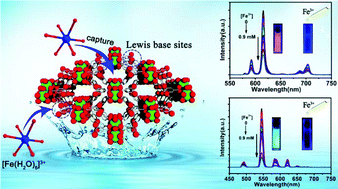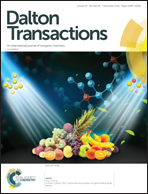Two water-stable lanthanide metal–organic frameworks with oxygen-rich channels for fluorescence sensing of Fe(iii) ions in aqueous solution†
Abstract
The development of metal–organic framework sensors with excellent stability under harsh physical and chemical conditions is of great significance in practical applications. Two isostructural lanthanide–organic frameworks, Ln-MOF ({Ln(L)(H2O)(DMA)}n, {FJU-13-Ln, Ln = Eu, Tb } (H3L = 3,5-(4-carboxybenzyloxy)benzoic acid)), were found to display exceptional stability, not only being stable in both acidic and basic aqueous solutions (pH 3–11), but also maintaining good robustness in boiling water and after activation. Furthermore, the plentiful oxygen atoms in the oxygen-rich channels of FJU-13-Eu and FJU-13-Tb acted as Lewis base sites for sensing metal ions, exhibiting high sensitivity (Stern–Volmer constant, KSV = 2.03 × 104 M−1 for FJU-13a-Eu and KSV = 2.11 × 104 M−1 for FJU-13a-Tb) and low detection limits (1.41 μM for FJU-13a-Eu and 1.01 μM for FJU-13a-Tb) for Fe3+ ions. This suggests that the two Ln-MOFs are promising fluorescent sensors for Fe3+ ion detection.



 Please wait while we load your content...
Please wait while we load your content...